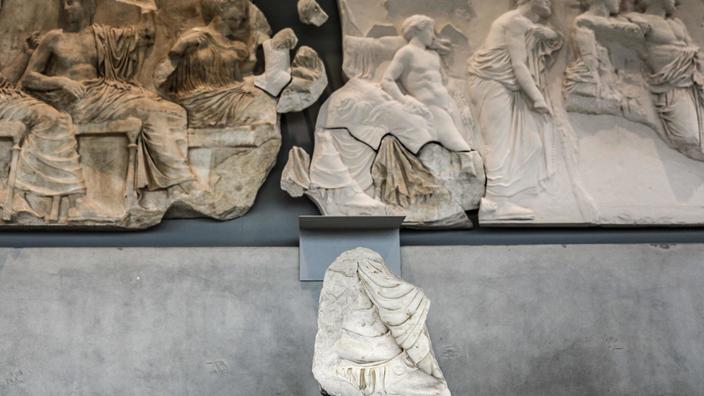Effervescence in Athens.
Visitors to the Acropolis Museum have been able for a few days to admire an ancient sculpture in its entirety: that of Artemis, the goddess of the hunt, and of nature.
The foot of this marble sculpture was exhibited until now at the museum of Palermo in Sicily, and has just been loaned for 8 years.
Its importance lies in the fact that it composed a fragment of the Parthenon frieze, which Greece is clamoring for to return.
Read also48 hours in Athens, our guide to vibrate with the Greek capital
This frieze, which represents the procession of the Panathenian festivals, is spread over 163 meters divided into 115 blocks of marble one meter high. "
The genius of Phidias is embodied in this frieze, because the famous sculptor of the Pantheon was able to bring these most important festivals of Antiquity to life, by bringing together men, animals and even the twelve gods of Olympus
" , explains Angelique Monsola, Acropolis guide and lecturer.
In 1816, Greece, under Ottoman occupation for four centuries, began its revolution, spurred on by renowned French artists (Eugène Delacroix, Victor Hugo, Hector Berlioz, Chateaubriand, etc.).
Lord Elgin, British ambassador at the time, buys it from the Ottomans, to
"protect"
it according to his words, and wins.
An illegal act of sale according to Athens.
Today, the vast majority of these marbles (80 meters) are in the British Museum in London.
To read also "Kitsch", "a horror": a statue of Maria Callas at the foot of the Acropolis horrifies the Greeks
The museum, located at the foot of the Acropolis, is the most visited in Greece (here January 4).
Alkis Konstantinidis / Reuters
The return of this Artemis foot, the first fragment of the frieze to return to the country, is considered a major victory for Greece, which hopes to bend the English.
However, for the moment, Athens faces the refusal of Boris Johnson, British Prime Minister, and the British Museum who do not even consider a loan of these marbles in the short term.
However, a poll published on November 26 in the Daily mail, revealed that 56% of English people questioned are in favor of a return.
Unesco support
To everyone's surprise, on Wednesday January 12, England made a 180-degree turn. For the first time since 1816, the famous Times newspaper of London takes, in an editorial, openly for the Greek cause and opens the way to a possible repatriation of this frieze. "
Times and circumstances have changed
" writes The Times "
the sculptures belong to Athens and must return there
" concludes the article.
“
For the Greeks, the question is not the restitution of the ancient artistic heritage, like the Venus de
Milo
, or the Winged Victory of Samothrace. In the case of the frieze, we are talking about an amputation
”continues Angelique Monsola. To make visitors aware of this aberration, Bernard Tschumi, the architect of the Acropolis Museum designed the top floor of the museum to be the same size as the Parthenon. But as only fifty meters of the marble pediment are original, he cast those outside Greece and in particular the British Museum in white plaster in order to better understand the extent of the problem. This is the reason why Greece, supported by Unesco and many European countries, is working to bring them together. A prospect now conceivable.

